Naming Origami Models
Origami models usually have names. Most often, these come from the models’ creators themselves, but they can also arise spontaneously among people folding the model, as is the case with many traditional designs. Designers can also consciously use names in order to attach additional meaning to their models and to indicate relations between similar designs.
In this post, I discuss issues related to naming origami models, some of which are not specific to origami but also affect other types of human creativity. I suggest the introduction of several terms which may be useful when discussing this topic, and present a selection of naming conventions used by different designers. Finally, I describe in detail the conventions I myself use, along with their rationale.
Since I work with non-figurative designs most of the time, this article is probably biased towards geometric origami models. If you would like to expand upon the topic of naming figurative models, or have any other comments, please do add your comments below this article, on social media, or get in touch with me.
Why names matter
Names fulfill the practical need of identifying origami models in discussion. However, they can also supply interpretation of how an origami work should be understood. A modular origami cube folded from black paper and called Cube is just a simple abstract design. Renaming the same model Kaaba makes it a figurative model with religious connotations.
In a way, naming things also frames the discussion. The way we talk about origami models affects our understanding of what origami is. Whether we call a single folded piece of paper a fold or an artwork affects the discussion of whether origami is an art form.
Similarities between the names of different origami models can imply similarities between the models themselves. Consistent naming conventions can make navigating the relations between different models easier.
Simple model names
Before we get into naming groups of related models, let’s have a quick look at names of individual models. I call names which do not use any special structure simple as opposed to compound names which I will introduce later.
Descriptive names
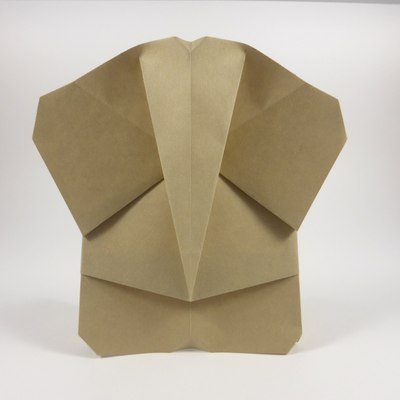
The most common convention seems to be using descriptive names which simply state what the model represents. For example, a model representing an elephant would be called Elephant. If an author designs multiple models representing elephants, their names will reflect some additional qualities allowing the models to be told apart from each other, leading to names such as Asian Elephant, African Elephant, Dollar Bill Elephant, etc. Note that some of these adjectives apply to the subject (the kind of elephant represented) while others apply to the model (design method, paper proportions and type, etc.).
A subtype of descriptive names which I think deserves a separate mention are technical descriptive names. These names, usually applied to abstract designs, describe what the model represents or how it is constructed but due to the description being very detailed, or the subject matter being abstract and complex, they sound more like technical descriptions than names. They can be as simple as Spiked Icosahedron from Bow-Tie Sonobe (Michał Kosmulski) or as complex as Ten Interlocking Irregular Hyperboloidal Equatorially Truncated Tri-diminished Trapezo-rhombic Dodecahedra (Byriah Loper). In the case of tessellations, apart from listing the types of molecules used and the way they are connected, strict notations can be used to create names which exactly describe the crease pattern. Examples of such systems can be found in Notation for a Class of Paperfolded Models (Goran Konjevod and Ana Maria Kuprešanin, in: Proceedings of Bridges 2009) and in Six Simple Twists, second edition (Benjamin DiLeonardo Parker). I haven’t seen the latter actually get used for naming models, but the former was used in such way, resulting in names such as Wave (15, 15 f).
A problem which may arise when a purely descriptive name is used, is the lack of a clear distinction between proper and common nouns. An author may design several elephant models and give them unique names, usually in the form <Adjective> Elephant, including a model called Elephant without any adjectives. Then, someone mentions folding this author’s elephant. At this point it’s difficult to tell if they meant the specific model called Elephant or any of the other models that have Elephant in their name, or even some other model representing an elephant, whose name might not even contain the word “elephant” at all, being called, for example, Giant.
The situation becomes worse when the author publishes several different models, each using exactly the same name, and doesn’t provide a way of telling them apart.
An additional issue, which I want to only mention in passing, is people distorting the official name when using it, for example by replacing parts of the name with synonyms (“simple” vs “easy”), changing a descriptive name to an equivalent but different one (Lucky Star Box vs Box with Lucky Star), etc. For example, the model Brick Wall by Yoshihide Momotani, is most often referred to as Momotani’s Wall, without the Brick.
Another common practice is translating a model’s name into another language (English Elephant vs Polish Słoń). This seems a natural thing to do for descriptive names, and this is how descriptive names are usually handled in other arts, such as painting or sculpture: Rodin’s Le Penseur is called The Thinker in English, Der Denker in German, etc. Translations introduce dozens of potential synonyms for any descriptive name. Even worse, translations do not always have a 1:1 correspondence with original names: Satoshi Kamiya’s Pegasus 1.0 and Pegasus B3.0 share their official English name, Pegasus, but their Japanese names are different, ペガサス and 天馬, respectively. Especially names of traditional models tend to not be translations but completely different names in different languages. The model known as fortune teller in English is also known (in English!) under the unrelated name cootie catcher, while its Polish and German names (piekło-niebo and Himmel oder Hölle, respectively) literally mean “heaven or hell”.
Changes such as described above may prevent the model from being uniquely identifiable even by a human, but even more so can they make searching for the model in a book or on the web much harder.
A possible solution, adopted for example by Robert Lang, is using opus numbers. This is a system originally invented for musical compositions which assigns each model a unique number, so that the name becomes something like African Elephant, Opus 322. This way even if the descriptive part becomes corrupted as it is passed on (Słoń afrykański, opus 322), the accompanying opus number still uniquely identifies the model.
Abstract names
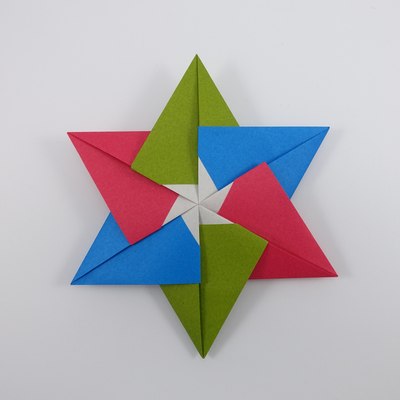
An author using only opus numbers, without the descriptive part of the name, would be using what I call abstract names, in this case just sequential numbers. Some real-life examples would be Lydia Diard using this very system (models named just 1217 and similar) or Andrea Russo’s date-based names (Tessella ante diem septimum Idus decembres) as well as models whose names include sequential Roman numbers (Tessella LVIII). Mixed systems are also in use, with model names such as 50-50-2021 #24 by Goran Konjevod where 50-50 stands for 50-50 Show, an exhibition for which the model was prepared, 2021 stands for the year and #24 is the number of the work in the series.
Sequential numbering does not need to be expressed with numbers or digits. Other possibilities include using series of words which are somehow related and may also have a well-defined order. For example, I have been using names of minor deities from Greek mythology, ordered alphabetically, for my modular stars: Ananke, Boreas, Chaos, Deimos, etc. The usage of names from Greek mythology may have originated with David Mitchell. Others have been using names from other large sets, not necessarily using any particular order at all. Here are some examples used by Carmen Sprung for her stars [source: private communication]: female and male names of origami friends, names of cities where she taught the star at an origami convention, special names for birthday presents, etc.
Another type of model names which I classify as abstract are names which consist of words that sound like a descriptive name, but can’t readily be associated with the model’s looks. They are usually applied to abstract models, and some can be considered extreme examples of poetic names. An example of a creator using names of this kind is Arseniy K., with models such as Mint Tea. Abstract names which look like descriptive names can sometimes be confusing. For example, Dragon (Joseph Hwang) is a kusudama rather than a figurative model.
Poetic names

I use the term poetic names for names which are not strictly descriptive, but which are still related to the model’s subject. Quite often, these names are used to give the model an additional layer of meaning beyond that which is visible at first glance. For example, Melina Hermsen decided to call her model Kongo Calling rather than Gorilla Head or some other direct description of the contents.
Taken too far, poetic names carry the risk of becoming pretentious and the model may be perceived as posing as something it is not.
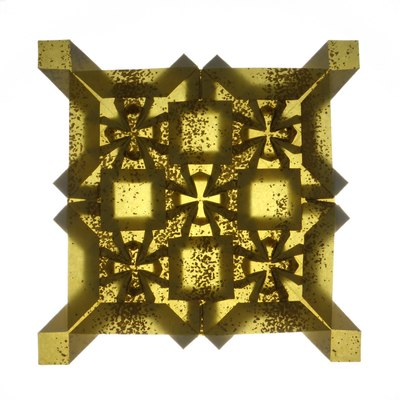
Poetic names based on far-fetched associations, which may be comprehensible to the author but not to the general public, form a spectrum which smoothly blends into abstract names.
Even though many (most?) traditional designs bear descriptive names (such as Crane or Paper Boat), some of them may well be considered poetic names. This results, at least to some degree, from the simplicity of those designs, which makes their association with their namesakes conjectural at best. For example, deciding whether the Pajarita actually resembles a little bird (which its name literally means), is left to the reader’s imagination. Likewise, some of the simple Froebelian designs were given names of everyday objects in order to allow children to associate them with something they knew, but due to their simplicity, one could probably classify them as abstract designs with poetic names. You can find examples of such names for example in Manuel Pratique de Jardins D’Enfants from 1859.
Unnamed models
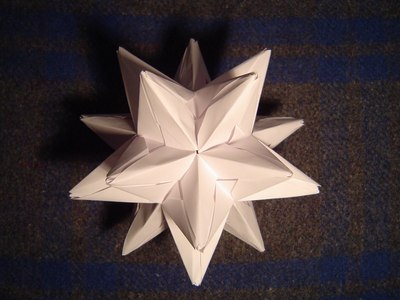
Sometimes designers publish models without giving them any names. This may be a result of the author paying more attention to designing and folding models than to naming them, but may also result from a lack of time or plain convenience. Such an approach is especially common on social media, with authors posting pictures without any title or description, or with just a technical ID such as serial filename from the camera. Other authors, for example Masha Athanasiadi, explicitly label their models No name, Unnamed, ?, etc. Sometimes a generic name such as Kusudama is used to the same effect.
Clearly, this makes referring to such models difficult. Apart from asking the author for a name in the post’s comments, the only unambiguous way of identifying such a model is using a phrase such as model posted by user Xyz on Instagram on 2021-06-22 which can be considered a kind of abstract name.
Finally, a model is often first assigned a name when it is published. In my drawers, I have dozens if not hundreds of designs which I have not yet folded cleanly or published. Still, the designs clearly exist (not only in the abstract but even in physical form), and yet have no names at this point.
What can happen to an unnamed model is that people discussing the model will coin some descriptive name which may later take on a life of its own, regardless of the author. This happens, in particular, to traditional designs, whose authors are by definition not known and thus have no control over naming. Additionally, such models tend to be known and folded over large spans of time and space which adds to the confusion. As David Mitchell states on his origami history page, such designs tend to have different names in different books, at different times and, of course, in different languages.
It may also happen that a model does have a name, but it is not propagated together with the model. For example, when a model is taught in an informal folding session at a convention, it may well be that participants remember the model, and possibly even teach it to others, but forget the name, or the designer, or both.
Synonyms

Apart from the issues mentioned before, such as names getting modified by accident or translated to another language, different names for the same model may also arise if multiple people independently create the same design. This happens quite often in the world of geometric origami. Usually author B publishes a design using their own name and only then learns that it was already published before by author A, under another name. This was the case with my Blintzed Bird Base Corrugation, which as I later learned, had also been independently designed by others before, in particular by Toshikazu Kawasaki who used the name Rhododendron.


Sometimes an author may wish to change a model’s name on purpose, for example to bring it in line with their new naming convention or to avoid ambiguity. This has happened to me: I used to call my Heart Tessellation II simply Heart Tessellation because I had forgotten I had published Hearts Tessellation some time earlier. I also got lost in my own numbering scheme for Woven Triangles family, and it took me about a year before I sorted out the differences and assigned unique names to Box with Woven Triangles I, XIII], and XVI.
Author’s name in model name
Since many authors call their origami elephant model simply Elephant, quite often the designer’s name has to be used as part of the model’s name (e.g. Elephant (Akira Yoshizawa)) since otherwise it would be impossible to tell the different Elephants apart.
Peoples’ names are a much more complex topic than they seem at first and in no way is there a single correct way to write a person’s name. To name just a few examples, people may be referred to by their first and last name, by last name only, by only some of their multiple first and last names, may change their names over time (e.g. due to marriage), may have their name written with or without diacritics, have their name written in several alphabets with multiple transliteration variants, use multiple artistic pseudonyms or social media handles, etc. Thus, for example, Dasa Severova, Dáša Ševerová, Ševerová, Dagmar Ševerová, Dáša, Dasssa, paperain and knitting_rain all refer to the same person.
Even within the relatively small community of active origami designers, people’s names might not be unique. Marking a model with just the last name of the author is not enough to tell apart models by Kota Imai and Yudai Imai. Even a person’s full name (first and last) might not necessarily be unique.
Versioning
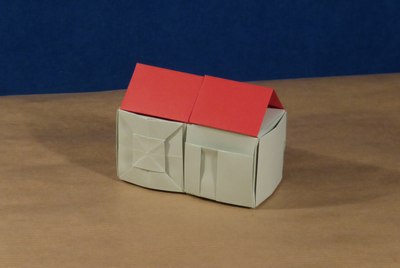
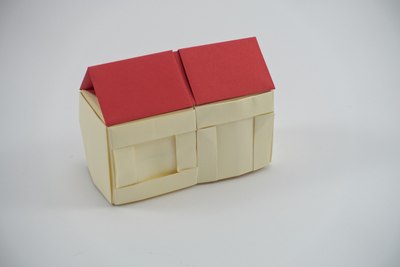
When a designer improves their model over time, they will often use the same simple name but with a version added, resulting in a name such as Tyrannosaurus 1.1 (JW Park). This is an example of what I call a compound name, in this case consisting of a simple name and a version number.
Versioning improvements is a useful concept, adapted from computer software. It seems to be common among designers to assume that the first published version is 1.0, and 1.1 to be an improved version. Version 1.0 is normally not explicitly attached to the name before there is at least one other version in circulation, i.e. an improved version such as 1.1 or 2.0 is published or an earlier version such as 0.9 was published before.
One of the most famous models which use version numbers is Satoshi Kamiya’s Ryu Zin (Ryujin), currently at version 3.5. Kamiya uses an interesting versioning scheme in which the version increases steadily in a progression of a design even if the design’s appearance and name drastically change in the process [source: personal communication and Kamiya’s FAQ, translated automatically into English]. A single version sequence gives rise to models with different names (note the inconsistency in English and Japanese names mentioned before) but a consistent “design history”, such as: Pegasus (ペガサス) → Tenma (天馬) 2.2 → Tenma (天馬) H-7 3.0 / Pegasus (天馬) B 3.0 The last design in the progression is split into two variants which branch off at 3.0 version.
Variants
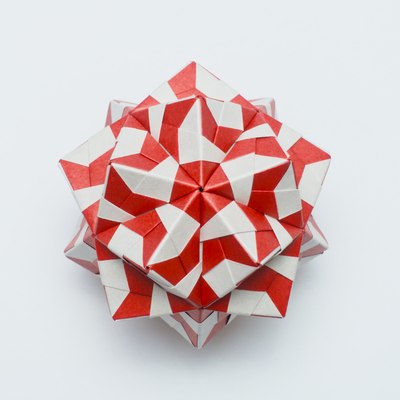
Many designers call minor modifications of a design, too small to call them separate designs, variants (or variations). In contrast to versions, different variants of a design are usually not considered improvements which supersede the previous one, but can co-exist in parallel. They are not better, just different.
Variants are very common in geometric designs, which are not limited by the need to be similar to a real-world subject. Sometimes, variants are created independently by many people, without the original designer being involved. There are literally hundreds of Sonobe unit variants, created by different people over dozens of years. Most often, such variants get descriptive names such as Star Sonobe (Maria Sinayskaya). Quite often, they remain unnamed, with authors describing their designs simply as “Sonobe variants” without further details. Since each author assigns names to their variants independently, there is little consistency in naming.
One possibility, which can be used for naming variants, but also versions or even alternate designs with the same simple name, is using the date. For example, Carmen Sprung says: Discovering new variations of a star after a number of years, I keep the name and add the year. Such a system still does not resolve ambiguities between variants created by different designers, though (unless everyone resolves to use timestamps with millisecond resolution).
Designs vs individual works

Before we move on to naming models related to each other, let’s stop for a moment and consider the ambiguity of the term model.
In the context of origami, the word model may refer either to a design, or to a particular work. A design is an abstract entity, defined by a sequence of folding steps, a crease pattern or some other kind of instructions, or just as a class encompassing some instances (works) created so far, as well as any number of works possibly folded in the future. A work, in contrast, is a singular, concrete fold, made from a concrete piece of paper (or other medium) and a materialization of the abstract design. This relationship is sometimes compared to composition and performance in music, and known as type-token distinction in logic.
The terms design and work are not an established standard. Various authors use different terms. Design seems to be quite popular, but for example Robert Lang uses composition as a nod to the musical analogy. Various terms, including fold and paperfold, get used for work. David Mitchell uses realisation while Robert Lang prefers artwork. Some terms, such as model or creation are ambiguous and can be used in both contexts. After considering many options (both those already used by others and new), and talking to a number of people, I arrived at the pair design and work, which I think reasonably balances unambiguity, brevity and neutrality.
Most origami designs can, and do, get folded multiple times, often by different people. Each fold is slightly different, but the amount of individual contribution from each folder varies: simple models based on precise reference points leave relatively little space for interpretation while complex models or models using few reference points, relying on curved and wet folding may result in each fold being significantly different. The role of reproducibility and uniqueness in art is an interesting topic, and has been discussed at least as early as the 1930-s in Walter Benjamin’s The Work of Art in the Age of Mechanical Reproduction (Das Kunstwerk im Zeitalter seiner technischen Reproduzierbarkeit). In the context of origami, it has been discussed at Outdoor Origami Meetings.
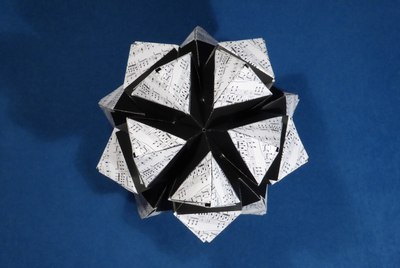
When it comes to naming, the distinction between design and work often becomes blurred. Sometimes authors explicitly state the name of the individual work and the name of the design. For an example, see the work С днем рождения, Наташа! (Valentina Minayeva) (Happy birthday, Natasha), whose description explicitly names the designs used to create the work: Electra by David Mitchell, Rose by Naomiki Sato, and Buds (by Minayeva?). As an aside, the matter of authorship in the case of models like this is also interesting.
Especially for origami works which are meant to be exhibited as artworks, it is common for the work name to be poetic or abstract even if the design uses a descriptive name. For example, Robert Lang’s Flying Peace and Flight of Folds are both based on the Flying Crane, Opus 563 design.
When folding instructions are published (be it in book form or in electronic media), one assumes that the name pertains to the design. However, most models are nowadays published in the form of pictures on social media. When we see a picture of an actual physical model (a work), whether online or at a live exhibition, it is not clear whether the name that accompanies the work pertains to the design or the individual work, which can be confusing. Red Flower Tessellation by Ilan Garibi was meant as a design name, but since the first fold of this design was from red paper (which gave the design its name), one might wrongly assume it was supposed to be just the title of a single work rather than of the design [source: personal communication].
Even if the author has a clear idea of work and design names, their intent may be subverted by others, who may, for example, start using the name clearly intended by the author to be a name of a single work to refer to the design.
Obviously, getting into such detailed distinctions by itself makes the discussion stricter and more technical. Generally, one can get the feeling that using a single name, that of an individual work, places the work more in the art world while mentioning the design name (alone, or in combination with work name), makes the work feel more like a feat of engineering than of art.
What is a design, anyway?
Surprisingly, it is not even quite clear what constitutes a separate origami design. Each design can be modified ever so slightly and the point where a modified design becomes a separate, new design, is not strictly defined. Design modifications form a continuous spectrum which seamlessly connects even very dissimilar designs through many intermediate forms. Even biologists have not solved the species problem despite many bright minds working on it for the last few hundred years.
Among figurative models of at least moderate complexity, this does not seem to be too much of an issue in practice. Minor changes such as bending an animal’s leg in a different direction are considered shaping and do not create a new design. In order for a model representing an elephant to become a model representing a horse, quite noticeable changes have to be introduced and will usually be recognized as a separate design. Intermediate forms might pose more of a challenge but since they do not look like any real animal, they are not of much interest and so do not get folded in practice, bypassing the naming problem. Corner cases certainly exist (maybe a horse and a donkey are similar enough for the intermediate models to be interesting), but as far as I know, they do not come up regularly.
Things are quite different with geometric designs. They often rely on repetition (e.g. modulars and tessellations) which often allows even a very small change in a single element (module or tessellation molecule) to strongly affect the whole model’s appearance in a kaleidoscopic effect. Due to their abstract nature, there isn’t a strong division of designs into islands of noteworthiness separated by seas of uninteresting intermediate forms: any modified form is as interesting as any other. As a result, creators often publish lots and lots of similar designs. Such closely related models pose new challenges when it comes to naming.
Even opus numbers do not solve all problems. The way Robert Lang uses them for modular origami [source: personal communication], an opus number is assigned to the design of the unit rather than to the work (comprised of multiple units connected in a specific way). However, works may still get individual names (usually of the poetic variety), listed together with opus numbers which serve as the more technical description. Therefore, on one hand, a single work may use multiple opus numbers if it is a modular made from multiple types of units, and on the other the same opus number may be assigned to works which look quite different (different shapes made from different numbers of units, as long as the unit is the same).
Modular origami

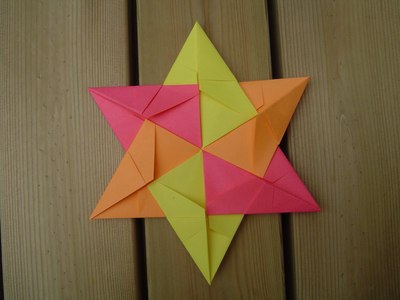
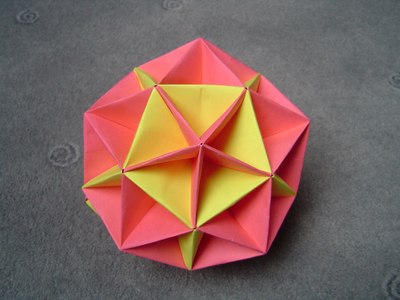
Modular origami poses a naming challenge since there are two parts to each work: the unit and the way of connecting the units. It seems clear that the two are to some degree independent. While there are units which only allow a single reasonable connection method and only a single interesting final object can be built from them, most units can be connected in multiple ways, some of which the unit’s author may not even have imagined. For example, Nick Robinson’s Trimodule was originally designed with only a simple star in mind, but others, including myself, used it to build a huge variety of 3D objects he had not thought of originally [source: private communication].
Thus, the unit and the objects built using the unit, need separate names. Since a single unit is rarely interesting enough to be considered a finished model in itself (with rare exceptions), in most cases the unit will only have a design name while assemblies made from the unit may have both design and work names. However, due to the way models get published, the two often become conflated. When a unit is published in the form of folding instructions, the final steps usually show assembling the units into some simple assembly. When, on the other hand, a design is published in the form of pictures (e.g. online), usually a whole assembly is presented, but the name (e.g. Xyz Kusudama) often sticks to the unit as well. It is often not clear whether this is what the author intended.
One obvious solution is to use the name of the geometric shape alongside with the module name, for example: 120-edge Buckyball (PhiZZ). Such a technical descriptive name is usually quite precise, but may lead to long and hard to pronounce names in case the base polyhedron is a complex one with a long name. A simplified method (practiced e.g. by David Mitchell) is using the module name along with just the number of units, resulting in names such as Electra 60. While there may be multiple designs using the same number of units, this convention at least results in short and easy to remember names.
Some modulars use several different unit types, and placing them all in a single name would make it rather complicated. Authors of such designs often use a poetic name, and explain the constituent designs only in the model’s description.
Tessellations
Just as in modular origami one needs to distinguish between a unit and models using that unit, origami tessellations, consisting of molecules, lead to the problem of distinguishing between the molecule and a complete tessellation.
Most often, tessellations are folded uniform, using all molecules of the same type, and thus the same name can be used for the molecule and for the complete tessellation. Unless a technical discussion of the model’s particulars is in place, the number of molecules is not as important as the number of modules in a modular design. This is because a tessellation stays the same basic shape no matter how many molecules it has whereas different polyhedra made from the same modular origami unit may lead to dramatically different geometries.
However, a number of complications are still possible: different molecule layouts, spacing, and margins are possible even for a single type of molecule. One can create tessellations that combine different kinds of molecules, use rotated grids, tessellations rolled into cylinders and other non-planar shapes in order to create lampshades and other 3D objects, etc. These modifications can usually be described quite precisely, but names formed in such a way may become very long and boring, to the point of being completely unpractical (e.g. in the case of using multiple molecule types connected in non-trivial ways). This often leads authors to adapt poetic or abstract names for such designs.
My naming conventions
In this part, I describe the naming conventions I myself currently use. Note that for various reasons, I am not always completely consistent, and you may find my designs which do not conform to these rules. Conventions are there to make life easier, so I don’t follow them if they don’t fulfill this goal. Another reason is that the ideas presented here evolved over time, and so older models may follow different conventions, or none at all.
The need for conventions
Why use any conventions at all? When I had just a few designs of my own, it was easy to give them unique names. As the number of my designs grew into dozens and hundreds, it became apparent that some of them were closely related to others, and I wanted their names to reflect this. I also wanted to avoid a false sense of accomplishment: some models are just minor modifications of others (often by different authors) and using completely unrelated names might imply that they were in fact completely new work. This issue is probably much more pronounced in geometric origami (and this is what I design most of the time) than in the case of representational models.
Naming conventions are used in many areas of science and engineering, for example in astronomy, biology, chemistry, and software development. There is even an established convention for naming cyclones, so having one for origami models isn’t such a far-fetched idea.
Most importantly, naming conventions introduce order and make it possible to reason about a model before looking at it in much detail.
General rules
I always give my models English names even though English is not my native language. The reason is I usually publish my models on the Internet or display them at origami conventions for an international audience. The rare cases of non-English names, or parallel English and non-English names are models whose names reference literature or history (e.g. Dwa miecze / Two Swords) and are thus rooted in a specific cultural context.
When my modulars end up with long names, I often introduce convenient abbreviations such as TEM for Trapezoid Edge Module.
Taking into account that English is a foreign language for much of my audience, I try to avoid names consisting of rare or difficult words when a simpler alternative is available, as well as words which are likely to be confused with others or accidentally replaced with synonyms. I also try to avoid names which would be difficult to find in search engines: I used WAsS as the abbreviation for my Weird Asymmetric Sonobe rather than WAS since was is the past tense of to be and would be almost impossible to find in Google or another search engine.
For figurative models, I most often use descriptive names, though for those more complex, such as origami paintings, I sometimes lean towards poetic names. For abstract designs, I try to find a descriptive name, but if I can’t find a nice and short one, I go for poetic or abstract names. I also often start with abstract names if I expect to fold multiple similar models which may be hard to find descriptive names for, such as modular stars. In this case I usually use names from a set, ordered alphabetically (for example, names of minor Greek deities for modular stars and names of Egyptian deities for kusudamas). This allows me to identify the type of the model by its abstract name.
Whether a name is descriptive, poetic, or abstract, I try to avoid using names which are already used by well-known models of similar type. Obviously, it’s hard to avoid that with simple descriptive names (an elephant is an elephant, after all, and it’s hard to think of a better name), but for poetic and abstract names I usually run quick flickr and Google searches to check if the name isn’t already used by another popular model of the same type by another author.
I also try to avoid using numbers in simple names since they may lead to ambiguities when used in compound names together with Roman numerals or version numbers.
The point of the guidelines listed above is avoiding confusion, so they’re just useful rules of thumb rather than hard and fast rules.
Variants
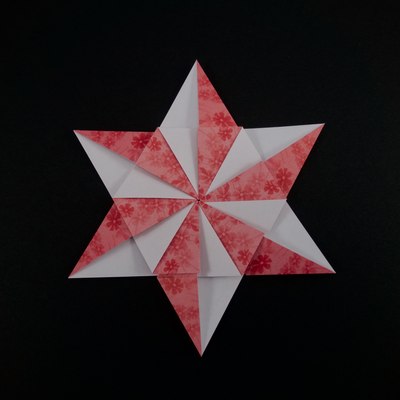
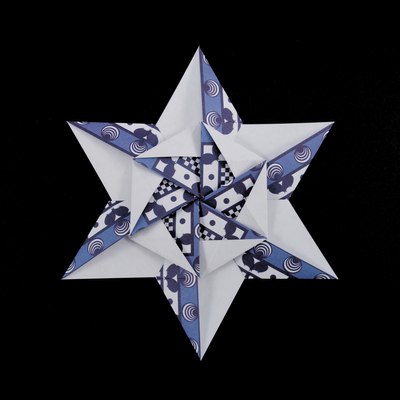
I use the term variant to refer to modifications of a model which are too minor to be considered separate designs. In the case of geometric designs such as tessellations and modulars, sometimes adding even a single crease in the molecule or unit can lead to a completely distinct look of the finished model. Since variants introduce only minor changes, I believe they should be seen as subordinate to versions, so the hierarchy goes: design → version → variant.
Looking at names, I first look for a good descriptive or poetic name (e.g. Paper Airplane Sonobe). Lacking that, I resort to marking the different variants with consecutive capital latin letters, for example: Star Ananke A (alternatively: Star Ananke variant A), Star Ananke B, …, Star Ananke G.
In order to avoid confusion, I try to consistently use either descriptive variant names or letters for variants of a single design, but to not mix the two.
Any design, when first created, can be considered variant A (of this very design). Since most designs do not have any additional variants, I do not mark the variant explicitly before creating more than one. This leads to some inconsistency as the model’s designation changes over time. I do append the A to the name right from the start if I have other variants, possibly unpublished yet, at the time of publishing the first one.
Multiple models with same subject
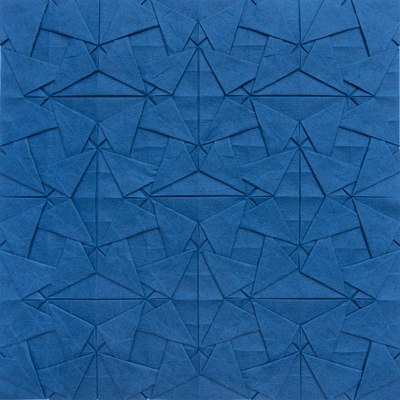
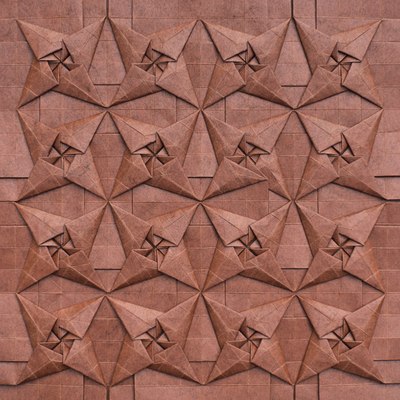
When I create multiple designs with the same subject, different enough to not consider them variants of a single design, I first try to find a descriptive name which could differentiate the two. For example, there’s Shamrock Tessellation and Shamrock Tessellation (simplified).
If it’s hard to come up with reasonably descriptive name fragments to tell the different models apart, I use sequential Roman numerals, for example: Woven Triangles Tessellation I, Woven Triangles Tessellation II, Woven Triangles Tessellation III, Woven Triangles Tessellation IV, etc. I call this trailing number the design number.
For brevity, I don’t introduce Roman numerals before they are needed, i.e. before I have at least two designs with the same subject. This leads to the issue of a model being referred to simply as Heart Tessellation at first but then me designing Heart Tessellation II which means in turn that I should have started referring to the former model as Heart Tessellation I. Such a change of name is a bit confusing, and also in practice it is not possible to retroactively change all mentions of a model’s name to the new name. On the other hand, most models never get a II or III model added, so appending I to each and every model when it is first published would be more trouble than it’s worth.
Versioning
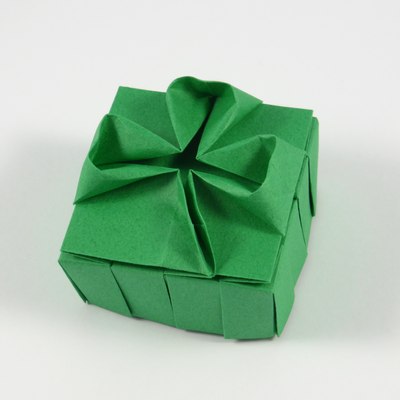

When I improve an already published design, whether visually or technically (e.g. by simplifying the folding sequence without sacrificing visual quality), I call the improved design a new version. The way to tell if I’m dealing with a new version as opposed to a design variant is asking myself: do I still care about the original design? If I do, since the new design is just a slightly different take on the subject, not better or worse than the old one, it means I’m dealing with a variant. If the new design is “the same thing, only better” and there is no reason to go back to the old one, it’s probably a new version.
I mark versions using the convention used in software, so a version number consists of digits separated by dots, for example: Shamrock Tessellation 1.1. There are always at least two numbers (the major and minor revision) in order to differentiate the version number from other numbers which might appear in a name, both visually and phonetically (Radioactive Tessellation 2.0, pronounced “two point oh”, would be an improved version of Radioactive Tessellation, while Radioactive Tessellation II, pronounced “two”, is a separate model with the same subject).
I normally treat the first (and often only) published version of a model as version 1.0. Minor improvements increase the minor revision number, leading to version 1.1, 1.2 etc., while major overhauls increase the major revision, leading to versions 2.0, 3.0, and so on. This roughly corresponds to the concept of semantic versioning. Just like variant A or the first attempt at a topic with the Roman numeral I, version 1.0 is normally not specified explicitly in the model’s name before any newer versions appear.
In software, more than two revision numbers are often used (e.g. 2.4.1). I have never needed such fine-grained versioning in origami so far (I rarely if ever even go beyond a single minor revision such as 1.1), but it could be used if needed.
Forming complex compound names
All elements of a name mentioned above can be combined in a single name if needed, leading to compound names such My Model III 1.2 C. The order should normally be: simple name, design number, version, variant, as in the example above. The elements are left-associative, meaning that the example should be interpreted as (((My Model) III) 1.2) C: variant C of version 1.2 of the third (III) design with the simple name My Model. If I improve the variant, it will become a new variant, marked with the next available letter. Since variants are supposed to be minor changes, there is no point in versioning them separately from the main design.
Sometimes, a model combines several design elements which can develop independently. A typical example from my repertoire are boxes with tessellation molecules: the molecule and the method used for creating a box based on the molecule are independent to some degree. A typical example of such a model is Shamrock Box. A model using an improved version of the molecule is then called Shamrock 1.1 Box, the version 1.1 being placed after Shamrock rather than after Box to indicate that it pertains to the molecule.
So far, I have not come up with a good way to tell apart a potential Shamrock (Box 1.1) and (Shamrock Box) 1.1. Very complex compound names such as Shamrock II 1.1 B Box IV 1.3 D are theoretically possible but might be a bit unwieldy in practice. Fortunately, so far I have never had the need to actually use such a complex name. Most of my designs have either one or two versions, sometimes multiple variants, but even finding a model with both a version higher than 1.0 and variants was hard.
Families
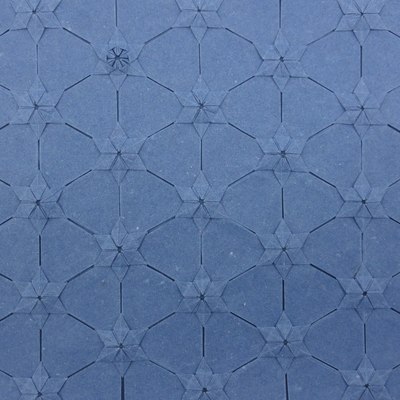
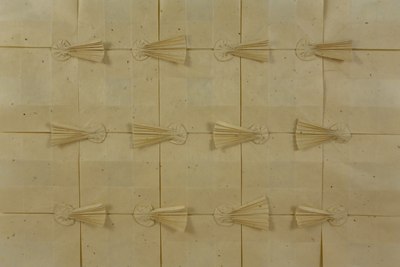

When a number of models share some significant elements of their structure, or have a similar subject, or both, I call such a set of models a model family. Such a family may include variants of a model but also models I consider separate, yet similar enough for the connection to be worth mentioning. Models in a family may, for example, incorporate the same tessellation molecule, or form a cycle of works related by subject. The term is rather fuzzy and allows for quite arbitrary grouping. The name of the family is not always included in a model’s name, but models in a family may share a part of their name in a manner similar to model variants using descriptive names. Thus, families may affect model naming, but they are themselves an independent concept (and one much more vague than versions or variants).
An example of a family whose members use quite diverse names is my Lucky Star family of models which includes, among others, Lucky Star Tessellation and Lucky Star Fractal but also, due to using a related molecule in the design, Christmas Tree 2018 and Epiphany III (which is, at the same time, a member of the Epiphany family).
Sometimes, the relations between designs do not become apparent right away. The above-mentioned Lucky Star Tessellation was first independently designed by Haligami who used the name Day and Night Tessellation. Lucky Star Fractal was first designed by Shuzo Fujimoto some time earlier. Later, each of these designs was independently rediscovered by multiple people who each used different names. Some of them explored the design in depth, others did not, and while some did find out that one was a generalization of the other, others probably didn’t. In my case, I first designed the non-fractal version and only later found out that a fractal could also be designed. Since some time passed in between, I already had a name for the non-fractal version. If I had come up with the fractal version first, I would probably not have bothered to give the non-fractal version a separate name. Many such hidden relations between models may still be lurking somewhere, waiting to be discovered and to cause confusion with model naming once they are.
Advantages and disadvantages
Advantages of the system described above include:
- the ability to easily tell apart multiple models with the same simple name (thanks to using Roman numerals)
- easily identifiable versions of the same model (version numbers always using a dot)
- easily naming variants (consecutive Latin letters)
- ability to combine all of the above in compound names
Disadvantages:
- Compound names may get complicated and dull (Box III 1.2 with Xyz II 2.3), though in practice they rarely do. Even a simple version number may make a poetic name much less poetic, though.
- Some ambiguities are still possible:
- I might mean the Roman numeral (multiple models with same simple name), the Latin letter (variant), or the word I (me); in practice, variants rarely go as far as the letter I, and the word variant can be added explicitly to avoid confusion (Some Model variant I vs Some Model I).
- Since one can’t tell apart Roman and Arabic numerals when they are read out loud, people not used to the system may write down the names they hear using the wrong kind of numerals.
- A simple name ending with a number, especially in Roman numerals, may lead to conflating the simple name with the suffixes that follow; for example, if I created a model dedicated to the computer game Doom II, the name could be interpreted as my second attempt at a model called Doom rather than the first attempt at a model called Doom II. In such a case, I would probably go for the name Doom 2 and while there is still a chance of confusion with Doom 2.0 (second version of Doom), this would resolve the ambiguity. Potential later names such as Doom 2 III 2.1 look a bit weird, though.
All in all, I have found the system to not be perfect, but still a big improvement over no system at all.
[update] Other approaches
When preparing this article, I searched for other publications about origami model naming but missed a long and interesting piece, Would a Kawasaki Rose by any other name smell as sweet? by Gerardo Gacharná Ramírez. His take on the subject is in some respects different from mine, and more opinionated, but it’s certainly worth reading. I wish to thank Tung Ken Lam who made me aware of this text’s existence.
Summary
In this article, I first present some methods of naming origami models used by different creators. I introduce the distinction between simple names and compound names, with simple names further divided into descriptive, abstract, and poetic names. Furthermore, I describe the hierarchy of designs, versions, and variants as well as how they affect naming (in particular, compound names). A discussion of the distinction between designs and individual works follows. Finally, I describe the naming conventions I myself use, along with their rationale.
Acknowledgements
Many people have contributed to this article. In, particular, I wish to thank Robert Lang for clarifying some use cases of opus names and for a very interesting discussion of the various terms used for designs and individual works. David Mitchell provided me with lots of interesting historic and current information as well as with details of the conventions he himself uses. Nick Robinson referred me to David Mitchell while also recalling the story behind his Trimodule. Ilan Garibi, Satoshi Kamiya, Goran Konjevod and Carmen Sprung answered my questions about their naming schemes, providing me with lots of interesting details. I also used a number of ideas which came about thanks to discussions with Marek Kosmulski and Bogna Kosmulska.
Comments